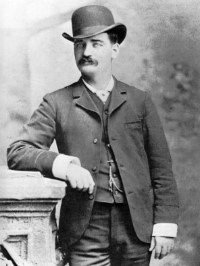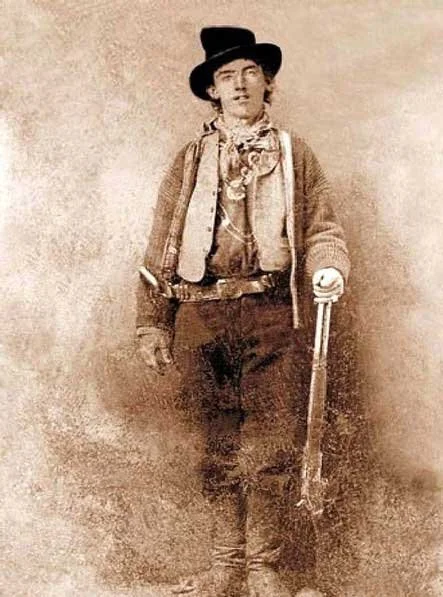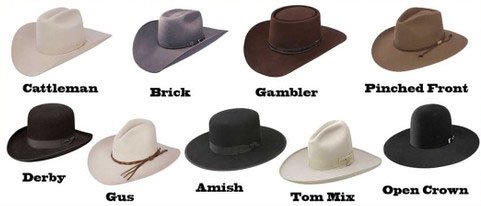History of the Cowboy Hat
The American West is symbolized by the trailblazing, sharpshooting, horseback-riding cowboy of American lore. Portrayed with the ubiquitous outfit of denim jeans with fringed chaps, boots with spurs & a plaid shirt. And though African-American cowboys don’t play a part in the popular narrative, historians estimate that one in four cowboys were black. This & other common tales about the cowboys of Hollywood legend aren't true:
They rarely fought Indians.
They were more likely to die from falling off a horse than in a gunfight.
They didn't wear those tall, wide-brimmed cowboy hats you see in Westerns.
The iconic Stetson came onto the market in 1865, and it wasn't popular until the end of the 19th century. A cowboy's preferred choice of hat? The Derby—also known as the Bowler.
The Bowler Hat is said to have been designed in 1849 by the London hat-makers Thomas and William Bowler to fulfil an order placed by the hatters Lock & Co. A customer had commissioned the hat to design a close-fitting, low-crowned hat to protect gamekeepers from low-hanging branches while on horseback at the estate of Thomas Coke, 1st Earl of Leicester. The keepers had previously worn top hats, which were knocked off easily and damaged. It is said that Europeans traveling to the colonies took these hats with them.
Photos of the Wild Bunch from 1892 and 1900 clearly show the gang—Harry A. Longabaugh (the Sundance Kid), Ben Kilpatrick (the Tall Texan), Robert Leroy Parker (Butch Cassidy), Harvey Logan (Kid Curry), and Will Carver—donning derby hats.
Famous gunslinger and gambler Bat Masterson also favored the Derby. The classic photo of American West gunfighter Billy the Kid depicts the outlaw wearing what resembles a top hat. Wild Bill Hickok was photographed in a flat pancake hat. An 1882 photo of Jesse James shows the outlaw in a low-crowned cap with the sides of the brim upturned.
Men commonly wore hats on the American frontier, and Derby hats were functional for various occasions. Most photographs from that time feature men wearing them, and one of the reasons they were popular is because they stayed on in windy conditions.
Frontiersman typically wore hats related to their employment, and they were commonly made of beaver fur-felt and were natural in color. In addition to the Derby, men wore flat wool caps, Mexican sombreros, or old Civil War hats (such as the kepi).
The popular image of a cowboy would not be complete without the wide-brimmed "10-gallon hat," yet even the most hardened cattlemen can't agree on how the iconic headgear first got its name. The conventional explanation is that "10-gallon" refers to how much liquid could be carried inside the hat. In fact, a famous ad for the Stetson company depicted a cowpoke giving his weary horse the last drop of water from the crown of his hat. While it's certainly in keeping with the romantic conception of life in the Old West, this image is probably as much of a myth as gunfights at high noon. Not only is the name "10-gallon hat" an obvious exaggeration—even the largest cowboy hats can only hold a few quarts of water.
Most experts argue that the name "10-gallon hat" is actually an import from south of the border. Cattle drivers and ranchers in Texas and the Southwest often crossed paths with Mexican vaqueros who sported braided hatbands—called "galóns" in Spanish—on their sombreros. A "10 galón" sombrero was a hat with a tall enough crown that it could hold 10 hatbands, but American cowboys may have anglicized the word to "gallon" and started referring to their own sombrero-inspired headgear as "10-gallon hats."
Yet another linguistic theory argues that the name is a corruption of the Spanish phrase "tan galán" —roughly translated as "very gallant" or "really handsome"—which may have been used to describe the majestic image of a hat-wearing cowboy in the saddle.
Whatever its origin, the 10-gallon hat wasn't even the preferred headgear for most people in the Wild West—top hats and bowlers were more common. The nickname didn't enter the popular lexicon until the 1920s when silent film stars like Tom Mix and Tim McCoy helped popularize the oversized hat in Hollywood Westerns. The 10-gallon hat went on to earn a place as a quintessential piece of the frontier wardrobe, and presidents like Harry Truman and Lyndon B. Johnson would later use them to cultivate a rustic image while serving as commander in chief.
The ten-gallon hat, would have been impractical, even if it was impressive to moviegoers. Famous lawmen such as Wild Bill Hickok and Wyatt Earp wore low-crowned hats because giant cowboy hats would have made them easy targets for adversaries.
The original Stetson was dubbed "The Boss of the Plains," and it didn't resemble what we think of as a cowboy hat today. It featured a high crown and wide brim and looked a bit like an Amish hat. It was waterproof and shielded the wearer from elements such as the sun and rain. Besides its practicality, a well-kept and clean Boss of the Plains hat was also regarded as a status symbol back in those days. Stenton's original design remained unchanged for almost 20 years. During that time, most of the hats were worn with open crowns and didn't have a designed crease.
John Stetson's classic cowboy hat was possibly inspired by the Spanish-derived hats he encountered after moving to the West. He created the iconic headwear, which features a crease in the middle of a high crown with a dent on each side, allowing the wearer to remove it by the crown instead of the brim.
An Apache man wearing “The Boss of the Plains” hat.
Legend is that he met a cowboy on the road who was so impressed by the hat that he gave John B. Stetson $5 for it (a relatively large amount at that time). The rest is history. By the 1870s, cowboys took to customizing their hats, and in 1872, Montgomery Ward Catalog sold hats that allowed men to shape the crowns and brim to suit their preferences.

















Meet Nadia Valavanis, founder and creator of BSVII ( BS- seven), who fuses her love of psychology and craftsmanship to turn her customer’s stories into stunning creations.